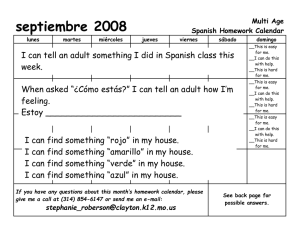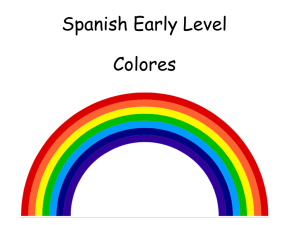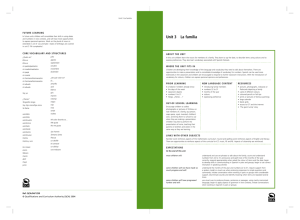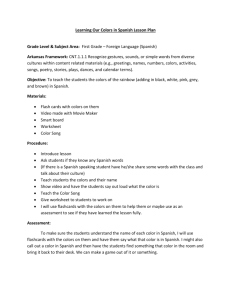Patterns Using Colors In Spanish
advertisement
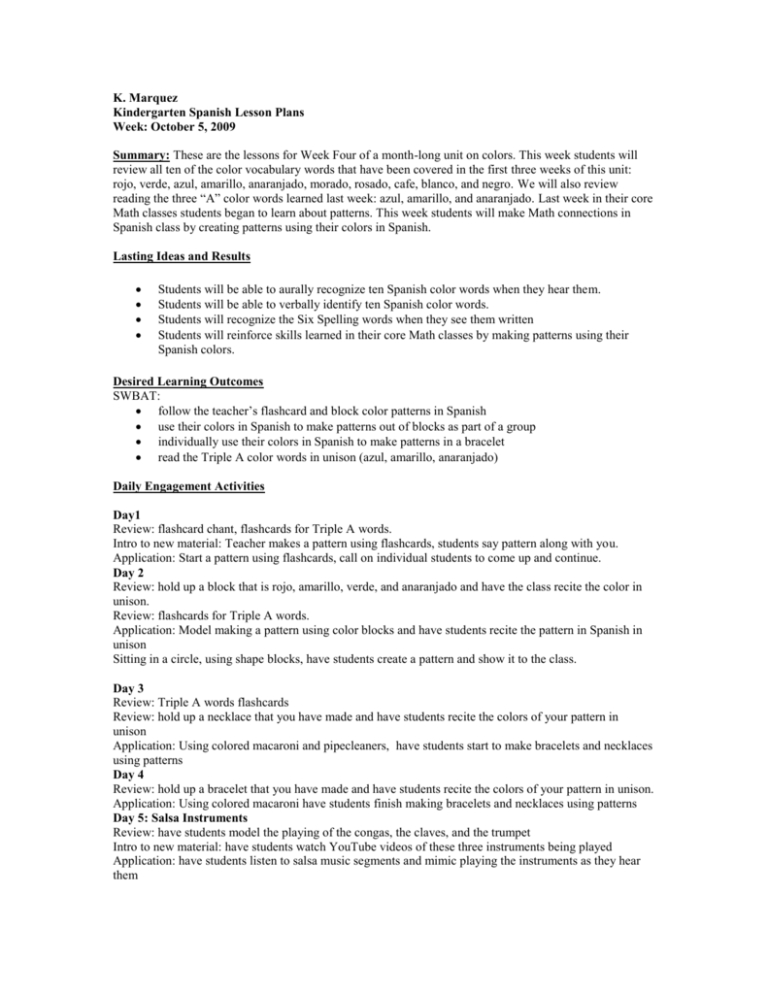
K. Marquez Kindergarten Spanish Lesson Plans Week: October 5, 2009 Summary: These are the lessons for Week Four of a month-long unit on colors. This week students will review all ten of the color vocabulary words that have been covered in the first three weeks of this unit: rojo, verde, azul, amarillo, anaranjado, morado, rosado, cafe, blanco, and negro. We will also review reading the three “A” color words learned last week: azul, amarillo, and anaranjado. Last week in their core Math classes students began to learn about patterns. This week students will make Math connections in Spanish class by creating patterns using their colors in Spanish. Lasting Ideas and Results Students will be able to aurally recognize ten Spanish color words when they hear them. Students will be able to verbally identify ten Spanish color words. Students will recognize the Six Spelling words when they see them written Students will reinforce skills learned in their core Math classes by making patterns using their Spanish colors. Desired Learning Outcomes SWBAT: follow the teacher’s flashcard and block color patterns in Spanish use their colors in Spanish to make patterns out of blocks as part of a group individually use their colors in Spanish to make patterns in a bracelet read the Triple A color words in unison (azul, amarillo, anaranjado) Daily Engagement Activities Day1 Review: flashcard chant, flashcards for Triple A words. Intro to new material: Teacher makes a pattern using flashcards, students say pattern along with you. Application: Start a pattern using flashcards, call on individual students to come up and continue. Day 2 Review: hold up a block that is rojo, amarillo, verde, and anaranjado and have the class recite the color in unison. Review: flashcards for Triple A words. Application: Model making a pattern using color blocks and have students recite the pattern in Spanish in unison Sitting in a circle, using shape blocks, have students create a pattern and show it to the class. Day 3 Review: Triple A words flashcards Review: hold up a necklace that you have made and have students recite the colors of your pattern in unison Application: Using colored macaroni and pipecleaners, have students start to make bracelets and necklaces using patterns Day 4 Review: hold up a bracelet that you have made and have students recite the colors of your pattern in unison. Application: Using colored macaroni have students finish making bracelets and necklaces using patterns Day 5: Salsa Instruments Review: have students model the playing of the congas, the claves, and the trumpet Intro to new material: have students watch YouTube videos of these three instruments being played Application: have students listen to salsa music segments and mimic playing the instruments as they hear them Procedures Class begins in a circle on the floor. I greet the class by saying "Buenas tardes, Jaguars!" and the class greets me back. I ask someone to translate "Buenas tardes" for the class. Students then sing the Buenas Tardes Song. We then review the rules: Your fingers are on your lips. You are sitting up tall and proud. You are trying your very best. You are following my directions the first time given. If the entire class is following the rules, you have a "happy face" on the board. If not, you have a "sad face" on the board. At the end of class if you still have a happy face on the board, the class will get a piece of the Wiggly Worm. Remind students that when the Wiggly Worm grows and grows and grows long enough to cross the finish line, the class will get a Small Sized Prize. I then introduce the Word of the Day using Sr. Hipopotamo: write the word of the day (in this case, rojo, azul, or another color word) on a 3x5 card and place it in the hippo's mouth. Call on a helper exhibiting Super Star behavior to take the Word of the Day out of the hippo's mouth. Have the class spell the word of the day and then pronounce it for the class. Have the class repeat what you have said. Give clues as to the meaning of the word (ie: Naheem is wearing a wrist band that is azul. Isabella is wearing a barette that is azul). Have students guess what the word means. Throughout the class I will ask, “Hmmm….what kind of a face should the class be getting right now?” If they are following the rules, then I will say “A happy face!”. If not, they get a sad face. At the end of class I announce whether they are getting a piece of the Wiggly Worm and then pick a helper to go put the piece up on the board outside the Art Room (they will pick either a piece of the body, a shirt, or a shoe and I staple it to the board.) Review: Triple A flashcards: (azul, anaranjado, amarillo) ask the class to spell each word in unison and ask who can READ the word and who can identify the color in English . Flashcard Game: (all colors) Pass out a flashcard to students who are showing beautiful behavior. Call out each color and have students hold up the cards as they hear their color. Application: Patterns: flashcards. Using the word chart, create a pattern using color picture flashcards (ie: rojo, rojo, verde, rojo, rojo, verde). Point to each color and have the class recite the color name in unison. Repeat with a two or three more patterns. Next, start patterns and call students up to the front to finish it: azul, azul, azul, amarillo. Azul, azul, azul ________. Patterns: blocks. While sitting on the rug, make a pattern using color blocks ie: (ie: rojo, rojo, verde, rojo, rojo, verde). Have the class model your pattern with their own blocks. Point to each color and have the class recite the color name in unison. Repeat with a two or three more patterns. If students have grasped this concept, have them make their own pattern using the blocks. Patterns: bracelets/necklaces Day Three. Sitting on the rug, show students a bracelet that you have made. Have them call out the names of the colors in unison. Have students make their own pattern using macaroni in four colors and call on two or three students to talk about their patterns. Patterns: bracelets/necklaces Day Four. Sitting on the rug, show students a bracelet that you have made. Have them call out the names of the colors in unison. Send students back to their seats to make their own pattern using four colors. Assessment Have students tell you about their pattern: do they correctly identify the colors in Spanish? Do they successfully create a pattern? V= creates a pattern and identifies colors without prompting M= needs one or two prompts to identify colors and create patterns A= needs three or more prompts to identify colors and create patterns N= cannot identify colors or create patterns even with three or more prompts and/or will not complete assignment Materials Word Chart Color picture cards Triple A word cards Color blocks Color-dyed pasta (four colors) Pipe cleaners Modifications,Adaptations, Accommodations Can adjust complexity of patterns according to student/class needs, i.e. more complex= azul, azul, rojo, rojo, rojo, azul, azul, rojo, rojo, rojo. Or simpler= azul, rojo, azul, rojo. Reflection Will advise.
